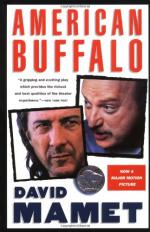|
This section contains 363 words (approx. 1 page at 400 words per page) |

|
American Buffalo Summary & Study Guide Description
American Buffalo Summary & Study Guide includes comprehensive information and analysis to help you understand the book. This study guide contains the following sections:
This detailed literature summary also contains Bibliography and a Free Quiz on American Buffalo by David Mamet.
Thorstein Veblen wrote that business wisdom, when reduced to its basest form, frequently resorts to "the judicious use of sabotage" an idea that David Mamet explores in his American Buffalo. First performed in Chicago in 1975, the play made its way to Broadway in 1977, Although Mamet had already achieved some success with his Sexual Perversity in Chicago (1972) the response to American Buffalo was highly favorable, despite the occasional harsh review. Many critics applauded Mamet's ability to capture the cadences and ambiguities in everyday American speech: Newsweek's Jack Kroll, for example, remarked that "Mamet is someone to listen to. He's that rare bird, an American playwright who's a language playwright." Edwin Wilson, writing in the Wall Street Journal, stated that Mamet "has a keen ear for the idiosyncrasies and the humor of everyday speech." While some critics dismissed American Buffalo (like the New York Daily News's Douglas Watt) as "a poor excuse for a play" and (like the Christian Science Monitor's John Beaufort) "too superficial to waste time upon," most were enthusiastic about Mamet's look at the ways in which three petty crooks plan to steal a coin collection in the name of "good business."
Mamet's plays (and this one is no exception) are radically different from ones written in previous theatrical eras and periods. Characters rarely speak in full sentences and their language (depending on the topic at hand) is often a mix of half-thoughts and obscenities, making the plays at tunes difficult to read. When performed, however, these seemingly inarticulate utterances yield a rhythm found in few other playwrights' work. "Part of the fascination of the play," wrote Women's Wear Daily's Howard Kissel, lies in "noting how the same banal language takes on different colors as we perceive the changing relationships" between the characters.
The conflict explored by Mamet here is the clash between business and friendship between a man's ethics and desire to succeed in a world where so much of the population has subscribed to a shared myth of capitalism. As one character tells his younger friend, "there's business and there's friendship"• two worlds which will be combined and then torn apart by the time the play is finished.
Read more from the Study Guide
|
This section contains 363 words (approx. 1 page at 400 words per page) |

|



